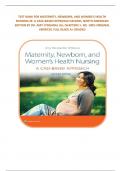TEST BANK FOR MATERNITY, NEWBORN, AND WOMEN'S HEALTH
NURSING 2E: A CASE-BASED APPROACH SECOND, NORTH AMERICAN
EDITION BY DR. AMY O'MEARA| ALL CHAPTERS 1- 30| 100% ORIGINAL
VERIFIED| FULL GUIDE A+ GRADED
,TABLE OF CONTENTS
Unit 1: Scenarios For Clinical Preparation .................................................................................................... 3
Chapter 1: Bess Gaskell: Immediate Postpartum Hemorrhage ................................................................ 3
Chapter 2: Tatiana Bennett: Later Postpartum Hemorrhage ................................................................. 14
Chapter 3: Susan Rockwell: Gestational Diabetes, Deep Vein Thrombosis, And Postpartum Pulmonary
Embolism................................................................................................................................................. 25
Chapter 4: Sophie Bloom: Preeclampsia ................................................................................................. 39
Chapter 5: Letitia Richford: Cord Prolapse And Nonreassuring Fetal Status .......................................... 49
Chapter 6: Rebecca Sweet: Placental Abruption And Fetal Loss ............................................................ 65
Chapter 7: Hannah Wilder: Chorioamnionitis And Neonatal Sepsis....................................................... 73
Chapter 8: Graciella Muñez: Preterm Premature Rupture Of Membranes And Neonatal Respiratory
Distress Syndrome .................................................................................................................................. 79
Chapter 9: Nancy Ng: Gestational Diabetes, Macrosomia, And Neonatal Cephalhematoma ................ 99
Chapter 10: Lexi Cowslip: Advanced Maternal Age, Hellp Syndrome, And Neonatal Necrotizing
Enterocolitis .......................................................................................................................................... 115
Chapter 11: Edie Wilson: Migraine With Aura, Shoulder Dystocia, And Brachial Plexus Palsy ............ 125
Chapter 12: Loretta Hale: Intimate Partner Violence, Formula Feeding, And Postpartum Depression
.............................................................................................................................................................. 135
Chapter 13: Tanya Green: Gestational Trophoblastic Disease (Molar Pregnancy) And Advanced
Maternal Age ........................................................................................................................................ 151
Unit 2: Maternity And Newborn Nursing For Uncomplicated Pregnancies.............................................. 160
Chapter 14 Before Conception ............................................................................................................. 160
Chapter 15 Pregnancy ........................................................................................................................... 174
Chapter 16 Labor And Delivery ............................................................................................................. 188
Chapter 17 After Delivery ..................................................................................................................... 204
Chapter 18 The Newborn...................................................................................................................... 220
Unit 3: High-Risk Conditions And Complications ...................................................................................... 242
Chapter 19 Conditions Existing Before Conception .............................................................................. 242
Chapter 20 Conditions Occurring During Pregnancy ............................................................................ 253
Chapter 21 Complications Occurring Before Labor And Delivery ......................................................... 276
Chapter 22 Complications Occurring During Labor And Delivery ......................................................... 292
Chapter 23 Conditions Occurring After Delivery .................................................................................. 304
Chapter 24 Conditions In The Newborn Related To Gestational Age, Size, Injury, And Pain ............... 316
Chapter 25 Acquired Conditions And Congenital Abnormalities In The Newborn ............................... 329
,Unit 4: Women’s And Gendered Health ................................................................................................... 346
Chapter 26 Wellness And Health Promotion ........................................................................................ 346
Chapter 27 Common Gynecologic Conditions ...................................................................................... 365
Chapter 28 Infections ............................................................................................................................ 385
Chapter 29 Family Planning .................................................................................................................. 393
Chapter 30 Vulnerable Populations ...................................................................................................... 406
Unit 1: Scenarios For Clinical Preparation
Chapter 1: Bess Gaskell: Immediate Postpartum Hemorrhage
MULTIPLE CHOICE
1. A Pregnant Woman Is Being Discharged From The Hospital After The Placement Of A Cervical Cerclage
Because Of A History Of Recurrent Pregnancy Loss, Secondary To An Incompetent Cervix. Which
Information Regarding Postprocedural Care Should The Nurse Emphasize In The Discharge Teaching?
A. Any Vaginal Discharge Should Be Immediately Reported To Her Health Care Provider.
B. The Presence Of Any Contractions, Rupture Of Membranes (Rom), Or Severe Perineal Pressure Should
Be Reported.
C. The Client Will Need To Arrange For Care At Home, Because Her Activity Level Will Be Restricted.
D. The Client Will Be Scheduled For A Cesarean Birth.
Answer>>B
Nursing Care Should Stress The Importance Of Monitoring For The Signs And Symptoms Of Preterm
Labor. Vaginal Bleeding Needs To Be Reported To Her Primary Health Care Provider. Bed Rest Is An
Element Of Care. However, The Woman May Stand For Periods Of Up To 90 Minutes, Which Allows Her
The Freedom To See Her Physician. Home Uterine Activity Monitoring May Be Used To Limit The
Woman's Need For Visits And To Monitor Her Status Safely At Home. The Cerclage Can Be Removed At
37 Weeks Of Gestation (To Prepare For A Vaginal Birth), Or A Cesarean Birth Can Be Planned.
2. A Perinatal Nurse Is Giving Discharge Instructions To A Woman, Status Post-Suction, And Curettage
Secondary To A Hydatidiform Mole. The Woman Asks Why She Must Take Oral Contraceptives For The
Next 12 Months. What Is The Best Response By The Nurse?
, A. "If You Get Pregnant Within 1 Year, The Chance Of A Successful Pregnancy Is Very Small. Therefore, If
You Desire A Future Pregnancy, It Would Be Better For You To Use The Most Reliable Method Of
Contraception Available."
B. "The Major Risk To You After A Molar Pregnancy Is A Type Of Cancer That Can Be Diagnosed Only By
Measuring The Same Hormone That Your Body Produces During Pregnancy. If You Were To Get
Pregnant, Then It Would Make The Diagnosis Of This Cancer More Difficult."
C. "If You Can Avoid A Pregnancy For The Next Year, The Chance Of Developing A Second Molar
Pregnancy Is Rare. Therefore, To Improve Your Chance Of A Successful Pregnancy, Not Getting Pregnant
At This Time Is Best."
D. "Oral Contraceptives Are The Only Form Of Birth Control That Will Prevent A Recurrence Of A Molar
Pregnancy."
Answer>>B
Beta-Human Chorionic Gonadotropin (Beta-Hcg) Hormone Levels Are Drawn For 1 Year To Ensure That
The Mole Is Completely Gone. The Chance Of Developing Choriocarcinoma After The Development Of A
Hydatidiform Mole Is Increased. Therefore, The Goal Is To Achieve A Zero Human Chorionic
Gonadotropin (Hcg) Level. If The Woman Were To Become Pregnant, Then It May Obscure The Presence
Of The Potentially Carcinogenic Cells. Women Should Be Instructed To Use Birth Control For 1 Year After
Treatment For A Hydatidiform Mole. The Rationale For Avoiding Pregnancy For 1 Year Is To Ensure That
Carcinogenic Cells Are Not Present. Any Contraceptive Method Except An Intrauterine Device (Iud) Is
Acceptable.
3. The Nurse Is Preparing To Administer Methotrexate To The Client. This Hazardous Drug Is Most Often
Used For Which Obstetric Complication?
A. Complete Hydatidiform Mole
B. Missed Abortion
C. Unruptured Ectopic Pregnancy
D. Abruptio Placentae
Answer>>C
Methotrexate Is An Effective Nonsurgical Treatment Option For A Hemodynamically Stable Woman
Whose Ectopic Pregnancy Is Unruptured And Measures Less Than 4 Cm In Diameter. Methotrexate Is
Not Indicated Or Recommended As A Treatment Option For A Complete Hydatidiform Mole, For A
Missed Abortion, Or For Abruptio Placentae.




